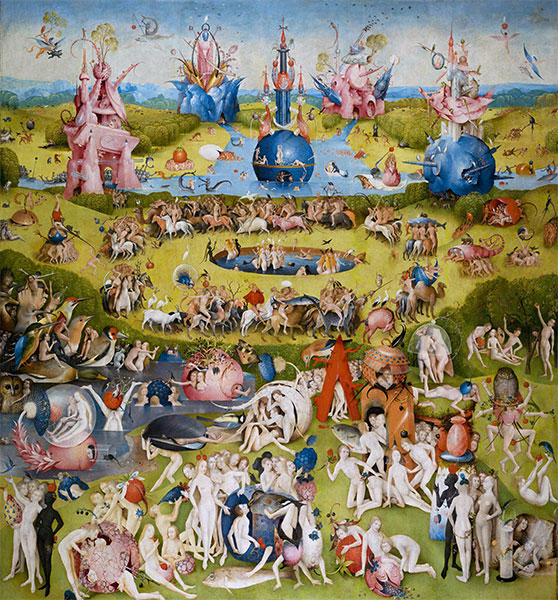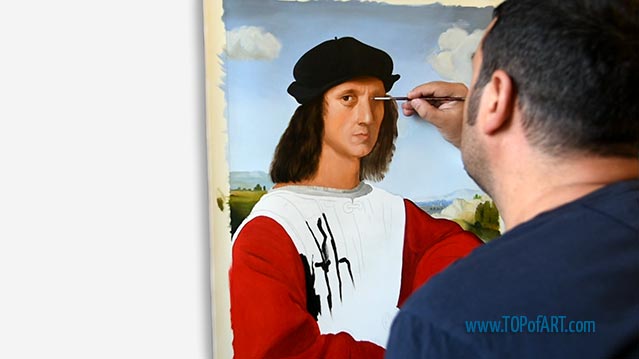Der Garten der Lüste, c.1490/00 Hieronymus Bosch (c.1450-1516)
Standort: Prado Museum Madrid SpainOriginalmaß: 183 x 171 cm
Ölgemälde Reproduktion
Wenn Sie eine andere Größe als die angebotene wünschen
Beschreibung
Gemalt von europäischen Künstlern mit akademischer Ausbildung
Museumsqualität
+ 4 cm Spielraum zum Dehnen
Erstellungszeit: 8-10 Wochen
Erstellungsprozess
Wir schaffen unsere Gemälde in Museumsqualität und unter Berücksichtigung höchster akademischer Standards. Die Gemälde-Reproduktion wird vollständig mit Ölfarben auf eine leere Leinwand gemalt. Wir fügen zusätzlich 4 cm leeren Abstand über die angebotene Gröβe hinzu, welche für strecken der Leinwand auf den Keilrahmen benutzt werden.
Die Schaffung Ihrer Hieronymus Bosch nimmt Zeit in Anspruch. Das Bild sollte nicht zu schnell gemalt werden, man sollte keinen Fristen hinterherjagen. Das Bild benötigt Zeit, um hohe Qualität und Detailtreue zu erreichen, sowie um vollständig versandbereit zu trocknen. Abhängig vom Aufwand, von der Detailgetreue und Bildgröße, brauchen wir 8-10 Wochen, um das Bild fertig zu stellen.
Wenn eine Änderung in Bezug auf die Frist notwendig sein sollte, oder sollte Ihre Bestellung in einer für uns äuβerst belebten Periode aufgegeben werden, werden wir Sie per E-Mail über die, von uns für Ihre Reproduktion gebrauchte Zeit, informiert.
Wir rahmen unsere Ölgemälde-Reproduktionen nicht ein. Die Ölgemälde sind ein kostenaufwendiges Produkt, und die Gefahr einer Beschädigung eines im Rahmen gespannten Gemäldes während des Transportes ist äuβerst hoch.
Außerdem gibt es postalische Beschränkungen bezüglich der Größe der Sendung.
Darüber hinaus kann der Versandpreis aufgrund der Abmessungen der gespannten Leinwand den Preis des Produkts selbst übersteigen.
Sie können Ihr Gemälde in Ihrem örtlichen Rahmengeschäft aufspannen und einrahmen.
Versand
Sobald das Gemälde Der Garten der Lüste fertig und trocken ist, wird es an Ihre Lieferadresse versendet.
Wir bieten kostenlosen Versand sowie kostenpflichtige Express-Transportdienste an.
Die Leinwand es eingerollt, in einem festen und sicheren Versandrohr. Sie können den Versandpreis mit dem Tool Geschätzte Steuern und Versandgebühren überprüfen.
Museumsqualität
TOPofART Gemälden stellen wir nur mit Museumsqualität her. Unsere Künstler mit akademischer Ausbildung lassen keine Kompromisse in Bezug auf die Qualität und der Detailtreue des bestellten Gemäldes zu. Wir pflegen keine Zusammenarbeit und werden nie eine solche mit Ateliers mit niedriger Qualität aus dem Fernen Osten zulassen. Wir sind in Europa ansässig, und Qualität ist unsere leitende Priorität.
1 Reviews
5.00 Gesamtbewertung
This exceptional triptych is of crucial importance in correcting the usual picture of Bosch as a participant in the supernatural and the apocalyptic, in magic, alchemy and witches, in a time of bloody persecutions and trials. According to the out-moded view, in depicting enigmas and hieroglyphs, monsters and hybrids, dreamlike juxtapositions and symbols of sin and folly, Bosch is the painter of the demoniac, of obsession with sexuality and all that perturbs the religious spirit. A great mass of literary interpretations has diverted attention from Bosch's style and prevented an authentic understanding of his work. If he sometimes intentionally loaded his art with representational functions (Christ Carrying the Cross in Ghent, where he rivals Metsys in the adoption of Leonardo's grotesques), he based them on a rigorous and 'rational' tendency to be found in Holland (Geertgen and followers, Master of the Virgo inter Virgines, etc.), and which is also connected with such French painters as Fouquet, the Master of Moulins, the Master of St. Sebastian. Furthermore, in working from the earliest Flemish masters, Bosch does not hesitate to learn from Jan van Eyck, the founding father of the tradition. There is no doubt that a fanciful intellectual climate, rich in myth and passions carried to the point of nightmare visions, gave Bosch the opportunity to insert a marvellously free kind of painting into an established idea of subject matter. The persistence of the Temptation of St. Anthony theme is better explained by the wealth of fabulous detail permitted by the legend, than by any veneration of the saint in the master's native town of's Hertogenbosch. And his inventive faculty was undoubtedly immense, inexhaustible, to such an extent that it has favoured an almost exclusive attention to his ever-surprising subject matter and reduced his work to a matter of anecdotes.
The forms of his paintings, however, are not all obscure or sunk in details; their clarity is carried to a point of transparent lucidity: the 'demoniac' is manifest in every supposedly tortured image. The transformation of the real into an autonomous vision is not accomplished through an iconography of the impossible, but first of all in terms of pictorial expression. The three parts of this triptych are unified by three large concentric perspective rings (to which the terrestrial globe on the outside of the wings corresponds), while below, the rigorous distribution of details along diagonals (and the corresponding perspective levels) makes possible an extremely dense elaboration of subordinate motifs, without dispersion or lapses in the narrative or illustration. All the individual forms are marked by a geometric purity which, in close correspondence with the rhythm, unifies each part; the part in turn is spontaneously linked with and flows into the next, with a continual transformation that is also an internal form of the highest coherency. A close rein is kept on the imaginative representation, and its reduction to basic, controlled modules. Accordingly, it is hard to know how to speak of the anxious, the troubled and the diabolic before these joyous sequences, in places somewhat ironical or frivolous, where life is seen in its infinite guises, in its hidden connections, in its possible transformations and passages, in all its impetus that pervades every object, animate or not. Here the nature of man is exalted; it is not an orgiastic vision, but lyrically contained by a style that personalizes and harmonizes every part of the work, which is meant to be read attentively throughout its clearly marked courses, where movement and rest alternate, and everything is of equal intensity, from the choral ensemble to the most secret detail. Bosch himself may be present in the vision, in a presumed self-portrait.

